Synchron FX Strings I
Introduction
Welcome to the Vienna Symphonic Library's series of Synchron Instruments! The instruments were recorded at Stage A, the main hall of Vienna's revitalized Synchron Stage Vienna. The recordings were executed using an expansive, phase-controlled multi-microphone set-up, capturing string effects played in a scoring stage with exceptional acoustics, now ready to be used in your studio.
Synchron FX Strings I is our most daring strings library to date, recorded with the signature ambience of our newly refurbished scoring stage, Synchron Stage Vienna. For the first time in Vienna Symphonic Library's long history of developing sample libraries, this Collection includes production-ready musical textures and loops using a 50-piece string orchestra, enabling you to create everything from ethereal, spheric soundscapes to pulsating melodic ornaments, suspense clusters and aggressive strikes!
We created this library with the wish to find new sounds, accessible through intuitive and musical handling, yet offering almost endless combinations and varieties. To get the most out of these sounds, we again raised the bar of our production efforts to create the utmost sonic depth and richness. The amount of microphones used was simply gigantic –resulting in a huge variety of sonic esthetics and possibilities such as stereo, 5.1, AURO 3D, etc. In addition, every musician of each group was miked individually with the aim to create a close-mic group mix providing access to the individual instrument groups.
Among other things, the library features two big sections called "Spherical textures" and "Spherical chord textures". While the "regular" textures can be played across the keyboard according to the mapped range, the chord textures consist of octatonic chords with C/B as their root key, including 1st and 2nd inversions. The intention was to create a sound that "fits" almost everywhere. As the variations of playing technique in these sections are the same, everything fits to everything, so that numerous combinations and variations are possible, the chord textures adding rich, deep and big sounds.
Musical FX soundscapes, moving, developing, changing colours and sounds are created on the fly by only moving some controllers.
Synchron FX Strings I is not limited to orchestral applications but can be used in any contemporary genre and style, such as Ambient, Alternative, EDM, World and many others.
Sound categories
There are 9 different sound categories, the 10th contains Articulations derived from the others:
- 01 Spherical Textures
- 02 Spherical Chord Textures
- 03 Character Textures
- 04 Glissandos
- 05 Rises + Hits
- 06 Clusters
- 07 Harmonic FX
- 08 Pizzicato FX
- 09 Special Pads
- 10 Inspiration XFades
Within these categories, there are different Patches according to the sounds they represent and their possibilities. However, all of the Patches contain mappings for low and high strings, and "dense" variations where applicable.
Standard and Extended Library
All the instruments were recorded not only with room microphones, but also with dedicated microphones for the individual ensemble sections. This not only allows you to realize stereo projects with the Standard Library – adding the Extended Library (and thus getting the Full Library) expands your possibilities to 5.1 surround and even Auro 3D 9.1.
Microphone positions
Standard Library
- Close Mic 1st Violins – Mono
- Close Mic 2nd Violins – Mono
- Close Mic High Violas – Mono
- Close Mic Low Violas – Mono
- Close Mic Cellos – Mono
- Close Mic Basses – Mono
- Mid Layer Mic, front of high string ens. – Stereo (L/R)
- Mid Layer Mic, front of low string ens. – Stereo (L/R)
- Main/Room Mic – Decca Tree Stereo (L/R)
- Main/Room Mic – Decca Tree Mono (Center)
Extended Library
- Back/Room Mic, back of high string ens. – Stereo (L/R)
- Back/Room Mic, back of low string ens. – Stereo (L/R)
- Main Surround – Stereo (L/R)
- High Stereo (3D) – Stereo (L/R)
- High Surround (3D) – Stereo (L/R)
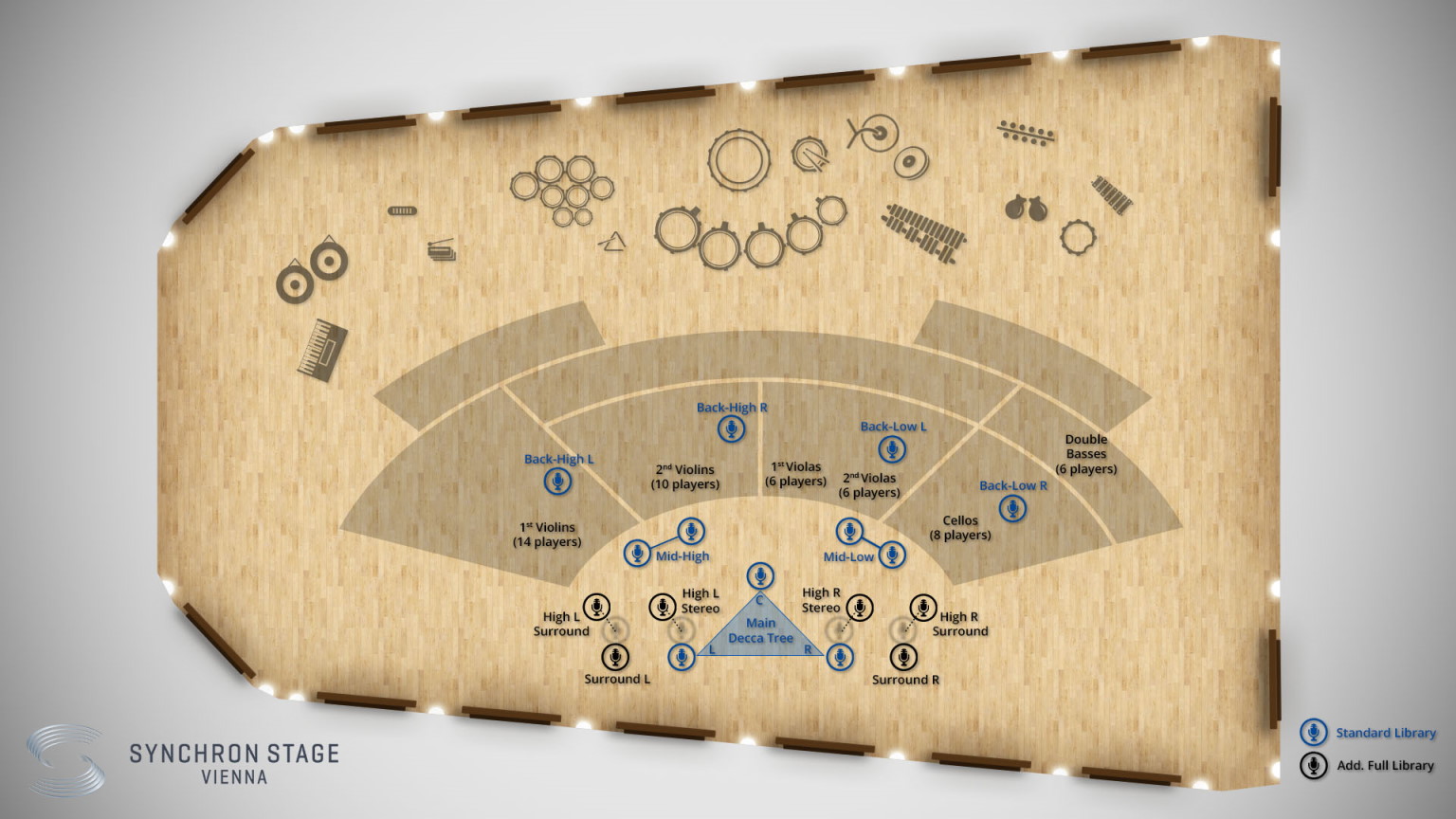
The main surround microphone settings may also be used instead of the main stereo room mics in order to achieve a wider and more ambient mix. Blending surround signals with the other microphone signals creates a denser, lusher overall sound, even in stereo applications.
About Pitch
For designating pitch, the Vienna Symphonic Library uses International Pitch Notation (IPN), which was agreed upon internationally under the auspices of the Acoustical Society of America. In this system the international standard of A=440 Hz is called A4 and middle C is C4. All pitches are written as capital letters, their respective octave being indicated by a number next to it. The lowest C on the piano is C1 (the A below that is A0), etc.
The Synchron Player Software allows you to set middle C to C3, C4, or C5 according to your preference. Selecting another setting than C4 will of course also change the play ranges and keyswitches accordingly.
Walkthrough Videos
Score
You can download the score here.
FX Strings I
The FX Strings Preset is structured according to effect type or 'Articulation'. By default the keyswitches for Articulations are mapped from C1 to A1 (for Middle C = C4), those for Variations start from C2. The first 9 Articulations contain Patches recorded specially for the respective category; the last one, 'Inspiration Xfades' provides crossfading options derived from the others.
Additional options within Variations are offered by the Dimension Controllers. The controller function is displayed in the respective caption, as of course it may take on different tasks – e.g., in Spherical Textures below Ctrl/A manages tempo variations, while Ctrl/B provides different bowing styles.
01 Spherical Textures
The Spherical Texture section contains slightly pulsing effects with aleatoric rhythms and random bow changes.
All Variations come in three different bowing styles: regular, half-tremolo, and ponticello. Bow styles crossfade with Dim.Ctrl/B (CC1).
Also, the Patch mappings contain "dense" variations, which are played in a faster tempo. These can either be mixed into the regular sound by way of Dim.Ctrl/A (CC3), or played separately in the upper mapping range.
- Samples: 2010
- Range: G#3–G7
- Velocities: pp, mf
- Play range mapping:
- G#3–G4 Low Strings – regular
- G#4–G5 High Strings – regular
- G#5–G6 Low Strings – dense
- G#6–G7 High Strings – dense
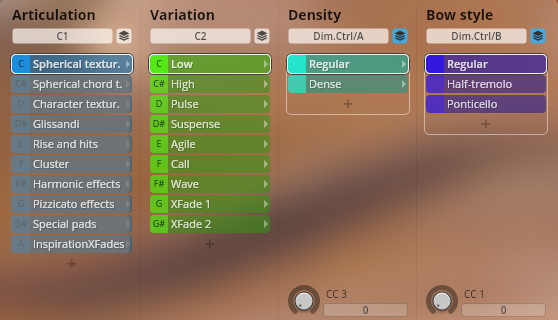
Variations
C2 Low
- These are low-range sounds with harmonics in octaves. Slight pulsing effects caused by aleatoric rhythms and bow changes create a beautiful spherical soundscape.
C#2 High
- The same as above, but featuring high-range sounds.
D2 Pulse
- Aleatoric pulsing harmonics in octaves.
D#2 Suspense
- The slight detuning effect in octaves generates a disquieting feeling of malaise and suspense.
E2 Agile
- The individual groups aleatorically play a little chromatic ornament, creating agile and nervous sounds.
F2 Call
- Fourth intervals played in staggered rhythms. Layering creates nice chord variations.
F#2 Wave
- Fast legato sixtuplets in the Lydian scale generate an undulating soundscape.
G2 XFade 1
- The Variation XFade controller allows you to crossfade between Pulse, Call, and Wave with Dim.Ctrl/C (CC4). No Density crossfade, 'dense' variations G#5–G7.
G#2 XFade 2
- The Variation XFade controller allows you to crossfade between Low, Suspense, and Agile with Dim.Ctrl/C (CC4). No Density crossfade, 'dense' variations G#5–G7).
02 Spherical Chord Textures
While the variations here are the same as for the Spherical Textures, the samples are based on the so-called 'Alpha chord' which consists of two symmetrically layered diminished seventh chords, with a whole tone gap in between. The chord's notes are derived from an alternating octatonic (eight-note) whole step-half step scale:
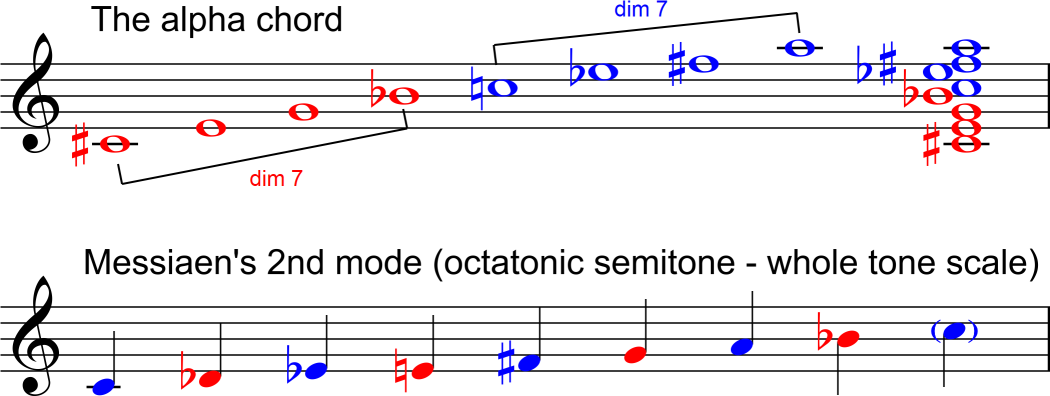
As in Spherical Textures above, all Variations provide three bowing styles crossfaded with Dim.Ctrl/B, as well as "dense" variations in a faster tempo (Dim.Ctrl/A for mixing, or separately in the upper mapping range).
The chords are based on the root keys C and B, respectively, with the root position mapped to their root keys, and first and 2nd inversions to the subsequent keys.
- Samples: 2014
- Range: B3–E7
- Velocities: pp, mf
- Play range mapping:
- C4, D4, E4 Low Strings, chord based on C
- B3, C#4, D#4 Low Strings, chord based on B
- C5, D5, E5 High Strings, chord based on C
- B3, C#5, D#5 High Strings, chord based on B
- B5–E6 Low Strings – dense
- B6–E7 High Strings – dense
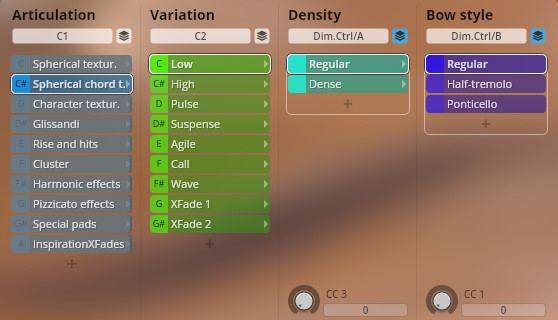
Variations
C2 Low
- These are low-range sounds with harmonics in octaves. Slight pulsing effects caused by aleatoric rhythms and bow changes create a beautiful spherical soundscape.
C#2 High
- The same as above, but featuring high-range sounds.
D2 Pulse
- Aleatoric pulsing harmonics in octaves.
D#2 Suspense
- The slight detuning effect in octaves generates a disquieting feeling of malaise and suspense.
E2 Agile
- The individual groups aleatorically play a little chromatic ornament, creating agile and nervous sounds.
F2 Call
- Fourth intervals played in staggered rhythms. Layering creates nice chord variations.
F#2 Wave
- Fast legato sixtuplets in the Lydian scale generate an undulating soundscape.
G2 XFade 1
- The Variation XFade controller allows you to crossfade between Pulse, Call, and Wave with Dim.Ctrl/C (CC4). No Density crossfade, 'dense' variations G#5–G7.
G#2 XFade 2
- The Variation XFade controller allows you to crossfade between Low, Suspense, and Agile with Dim.Ctrl/C (CC4). No Density crossfade, 'dense' variations G#5–G7).
03 Character Textures
Screaming and shouting high strings and grumbling low strings, aleatoric cluster FX with random pizzicatos, dirty and aggressive sounds with high bow pressure, ethereal "outer space" sounds performed behind the bridge, staggered, pulsating bow repercussions on a string, melodic ornaments in the Ionian scale. 'Dense' variants (Dim.Ctrl/A) according to Variation. Bow styles (Dim.Ctrl/B): regular, half-tremolo, ponticello (indicated if there are not all three).
- Samples: 978
- Range, velocities, mapping: according to Variation
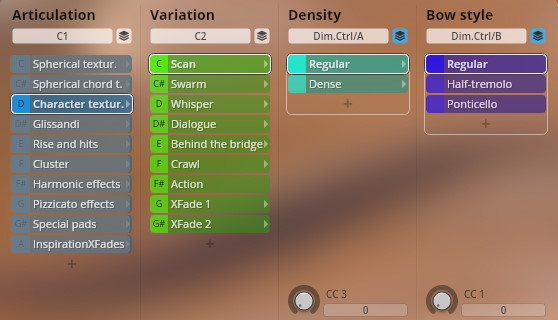
Variations
C2 Scan
- Aleatoric fifth/fourth-arpeggios create wide, pulsing soundscapes. The "dense" variation is played in a faster tempo.
- Range: G#3–G7
- Velocities: pp, mf
- Play range mapping:
- G#3–G4 Low Strings – regular
- G#4–G5 High Strings – regular
- G#5–G6 Low Strings – dense
- G#6–G7 High Strings – dense
C#2 Swarm
- A very aggressive and 'dirty' sound resulting from playing with strong bow pressure near the frog of the bow, but with little bow movement. Bow styles: regular, half-tremolo.
- Range, velocities, mapping: as above.
D2 Whisper
- Aleatoric melodic ornaments in the Ionian scale. The variations feature rhythmical differences, octaves, and glissandos.
- Range: A#3–G6
- Velocities: pp
- Play range mapping:
- A#3–D4 Low Strings, var.1
- D#4–G4 High Strings, var.1
- A#4–D5 Low Strings, var.2
- D#5–G5 High Strings, var.2
- A#5–D6 Low Strings, var.3
- D#6–G6 High Strings, var.3
D#2 Dialogue
- Rhythmic and melodic cluster aleatoric with random pizzicatos create a grumbling chatter in the low strings and a screaming shouting in the high strings. Bow styles: regular, ponticello.
- Range: A#3–G6
- Velocities: pp, mf, f
- Play range mapping: as above
E2 Behind the bridge
- Here the ensembles play behind the bridge. The articulation results in a cluster-like, "outer space" sound canvas. Bow styles: regular, half-tremolo.
- Range: A#3–G6
- Velocities: pp, mf
- Play range mapping:
- A#3–G4 Low Strings – regular bowing
- A#4–G5 High Strings – regular bowing
- A#5–G6 Low Strings – arpeggios
- A#6–G7 High Strings – arpeggios
F2 Crawl
- Staggered bouncing of the bow on the strings creates a percussive and pulsating string sound. Again, the "dense" variation is created by faster bouncing. No bow style variants.
- Range: G#3–G7
- Velocities: pp, mf
- Play range mapping:
- G#3–G4 Low Strings – regular
- G#4–G5 High Strings – regular
- G#5–G6 Low Strings – dense
- G#6–G7 High Strings – dense
F#2 Action
- For this exquisite Patch, the musicians were asked to play music which is technically not feasible, hence creating a highenergy performance right 'over the top'. No bow style variants.
- Range: A#3–G7
- Velocities: p, f
- Play range mapping:
- A#3–D4 Low Strings, var.1
- D#4–G4 High Strings, var.1
- A#4–D5 Low Strings, var.2
- D#5–G5 High Strings, var.2
- A#5–D6 Low Strings, var.3
- D#6–G6 High Strings, var.3
- A#6–D7 Low Strings, var.4
- D#7–G7 High Strings, var.4
G2 XFade 1
- The Variation XFade controller (Dim.Ctrl/C, CC4) allows you to crossfade between Crawl, Scan, and Swarm.
G#2 XFade 2
- The Variation XFade controller (Dim.Ctrl/C, CC4) allows you to crossfade between Whisper, Dialogue, and Action.
04 Glissandos
Regular and fingered, as well as cross glissandos, with speed variations. All glissandos are available in regular, half-tremolo, and ponticello bow styles (Dim.Ctrl/B, CC1).
- Samples: 864
- Velocities: p, f
- Range, mapping: according to Variation
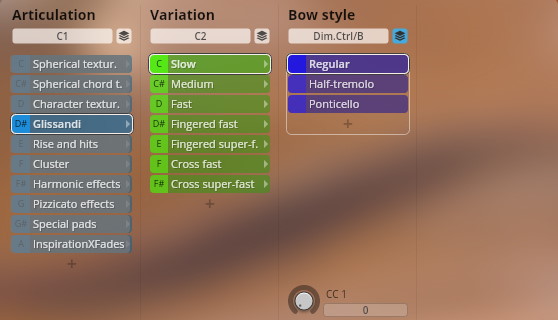
Variations
C2 Slow, C#2 Medium, D2 Fast
- Regular glissando played with one finger in various tempos. By staggering layers of the slow tempo variations it is possible to creates a nice "endless" glissando (Shepard effect).
- Range: G#3–G7
- Play range mapping:
- G#3–G4 Low Strings – up
- G#4–G5 High Strings – up
- G#5–G6 Low Strings – down
- G#6–G7 High Strings – down
D#2 Fingered fast, E2 Fingered super-fast
- These are 'scale-like' fingered glissandos which generate more power than the regular ones.
- Range, mapping: as above.
F2 Cross fast, F#2 Cross super-fast
- Glissandos played with one finger, where half the players go up and the other half go down.
- Range: G#3–G5
- Mapping:
- G#3–G4 Low Strings
- G#4–G5 High Strings
05 Rises + Hits
Upwards runs and glissandos with high dynamics and big crescendo, with speed variations. Bow styles: regular and tremolo (Dim.Ctrl/B, CC1). The slow Variations also feature super-slow variants.
Samples: 1800
Velocities: p, f
Range: slow G#3–G7, fast G#3–G5
Play range mapping slow:
- G#3–G4 Low Strings – slow
- G#4–G5 High Strings – slow
- G#5–G6 Low Strings – super-slow
- G#6–G7 High Strings – super-slow
Play range mapping fast:
- G#3–G4 Low Strings
- G#4–G5 High Strings
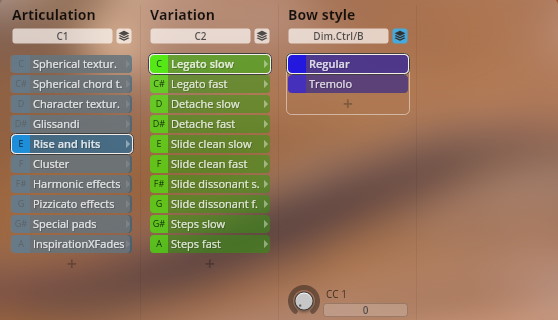
Variations
C2 Legato slow, C#2 Legato fast
- 'Scale-like' fingered legato upwards runs with an accent on the last note.
D#2 Detache slow, D#2 Detache fast
- 'Scale-like' fingered détaché upwards runs with an accent on the last note.
E2 Slide clean slow, F2 Slide clean fast
- 'Clean' upwards one-finger glissandos with an accent on the last note.
F#2 Slide dissonant slow, G2 Slide dissonant fast
- Dissonant upwards one-finger glissandos with an accent on the last note.
G#2 Steps slow, A2 Steps fast
- Staggered upwards one-finger glissandos with an accent on the last note.
06 Clusters
Short and long note clusters, as well as glissando clusters with speed variations. All bow styles (Dim.Ctrl/B, CC1) except the 'Short' Variation (regular and ponticello only).
- Samples: 888
- Velocities: p, mf, ff
- Range, mapping: according to Variation
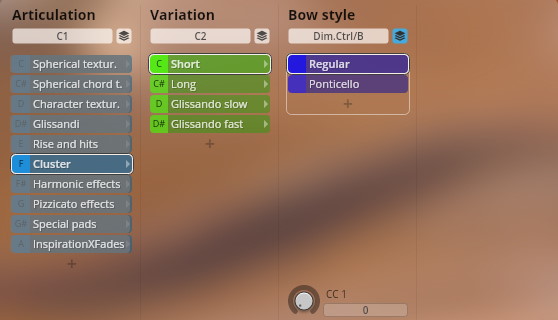
Variations
C2 Short, C#2 Long
- Short staccato / long sustained notes, fifth-range clusters.
- Range: C4–C6
- Play range mapping:
- C4–C5 Low Strings
- C#5–C6 High Strings
D2 Glissando slow, D#2 Glissando fast
- Slow / fast one-finger glissandos, up and down, clusters in fifth range.
- Range: A#3–G6
- Mapping:
- A#3–D4 Low Strings – up
- D#4–G4 High Strings – up
- A#4–D5 Low Strings – down
- D#5–G5 High Strings – down
- A#5–D6 Low Strings – cross
- D#6–G6 High Strings – cross
07 Harmonic FX
Features "freaky" harmonics, e.g., slightly detuned harmonics, and upward and downward glissandos. Only regular bow styles except 'Natural harmonics rubbing' (regular, tremolo).
- Samples: 332
- Velocities: p, mf
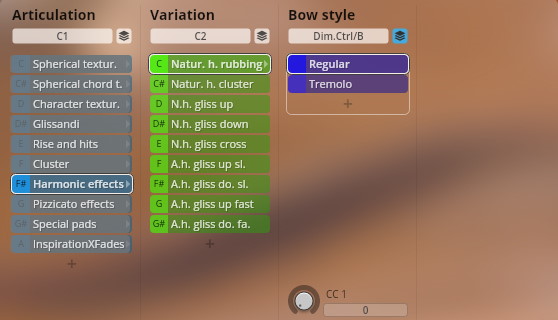
Variations
C2 Natural harmonics rubbing
- Natural harmonics, slightly detuned, creating a unique "organesque" sound. Bow styles: Dim.Ctrl/B, CC1.
- Range: A3–G7
- Play range mapping:
- A3–E5 Low Strings (root keys C4, G4, D5)
- F5–G7 High Strings (root keys G5, D6, A6, E7)
C#2 Natural harmonics cluster
- Natural harmonics clusters, creating otherwordly, eerie sounds.
- Range: G#3–C6
- Play range mapping:
- G#3–A4 Low Strings
- A#4–C6 High Strings
D2 N.h. glissando up, D#2 N.h. glissando down, E2 N.h. glissando cross
- Upwards / downwards /cross glissandos with arpeggio-like effects.
- Range: A3–G7
- Play range mapping:
- A3–E5 Low Strings (root keys C4, G4, D5)
- F5–G7 High Strings (root keys G5, D6, A6, E7)
F2 Artificial harmonics glissando up slow, F#2 Artificial harmonics glissando down slow
- Artificial harmonics, slow upwards / downwards glissandos.
- Range: A#3–G7
- Play range mapping:
- A#3–D4 Low Strings – string 1 (root key C4)
- D#4–G4 High Strings – string 1 (root key F4)
- A#4–D4 Low Strings – string 2 (root key C5)
- D#5–G4 High Strings – string 2 (root key F5)
- A#5–D4 Low Strings – string 3 (root key C6)
- D#6–G4 High Strings – string 3 (root key F6)
- A#6–D4 Low Strings – string 4 (root key C7)
- D#7–G4 High Strings – string 4 (root key F7)
G2 A.h. glissando up fast, F#2 A.h. glissando down fast
- Artificial harmonics, fast upwards / downwards glissandos.
- Range, mapping: as above.
08 Pizzicato FX
Cluster pizzicatos, finger glissandos after the pizzicato, and random pizzicatos in various tempos.
- Samples: 324
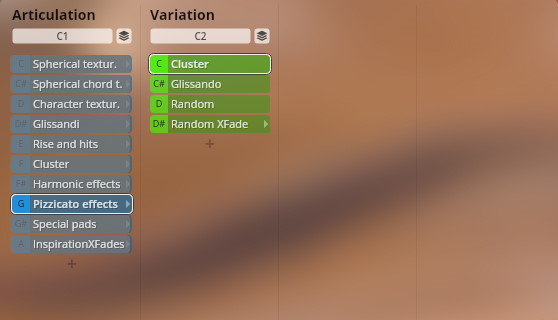
Variations
C2 Cluster
- Pizzicato clusters in fifth range.
- Range: B3–D5
- Velocities: pp, mp, f, snap
- Play range mapping:
- B3–F4 Low Strings
- F#4–D5 High Strings
C#2 Glissando
- Pizzicatos with subsequently applied finger glissando.
- Range: A#3–G6
- Velocities: p, f
- Play range mapping:
- A#3–G5 Low Strings
- G#5–G6 High Strings
D2 Random
- Detuned random pizzicatos in different tempos create intriguing textures.
- Range: C4–F5
- Velocities: pp, mp, f
- Play range mapping:
- C4 / D4 / E4 / F4 Low Strings – Slow / Medium / Fast / Accelerando
- C5 / D5 / E5 / F5 High Strings – Slow / Medium / Fast / Accelerando
D#2 Random XFade
- Detuned random pizzicatos, with crossfade option (Dim.Ctrl/A, CC3) between slow, medium, and fast tempo.
- Range: G#3–G7
- Velocities: p, f
- Play range mapping:
- G#3–G4 Low Strings
- G#4–G5 High Strings
- G#5–G7 is a duplicate for use in the Inspiration XF section.
09 Special Pads
Various FX sounds, e.g., the strings tuned down by a minor third. No bow style variants.
- Samples: 288
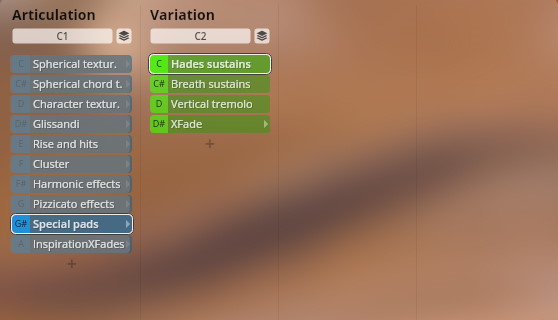
Variations
C2 Hades sustains
The strings tuned down by a minor third produce a special, warm and soft sound quality.
- Range: A2–F6
- Velocities: pp, mf
- Play range mapping:
- A2–G4 Low Strings
- G#4–F6 High Strings
C#2 Breath sustains
- Very fast bow tempos almost without pressure on the strings result in an extraordinary, very breathy sound.
- Range: A#2–C6
- Velocities: pp
- Play range mapping:
- A#2–A#4 Low Strings
- B4–C6 High Strings
D2 Vertical tremolo
- Vertical bow tremolo is created by the musicians bowing up and down the fingerboard, and thus producing a very noisy and almost non-tonal sound.
- Range: A#2–F6
- Velocities: pp, mf
- Play range mapping:
- A#2–G4 Low Strings
- G#4–F6 High Strings
D#2 XFade
- Provides a crossfading option (Dim.Ctrl/C, CC4) between Breath sustains, Hades sustains, and Vertical tremolo. Please note that the play ranges of the three Articulations differ, and the range where crossfading is possible does not exceed the Variation with the smallest range.
- Range: A2–C7
- Velocities: according to Articulation
- Active play range:
- A#2–G4 Low Strings
- G#4–F6 High Strings
10 Inspiration XFades
This section offers you crossfading combinations of Variations from different Articulation sections. Variations are crossfaded with Dim-Ctrl/C (CC4), other options – e.g., bow styles – according to Variation.
- Samples: 1852
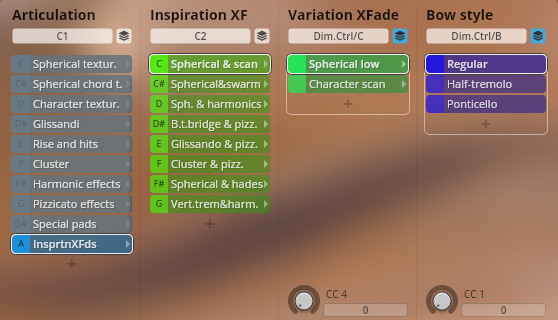
Variations
C2 Spherical & scan
- Spherical low and Character scan.
- Range: G#3–G7
- Play range mapping:
- G#3–G4 Low Strings – regular
- G#4–G5 High Strings – regular
- G#5–G6 Low Strings – dense
- G#6–G7 High Strings – dense
C#2 Spherical & swarm
- Spherical low and Character swarm.
- Range, mapping: as above.
D2 Spherical & harmonics
- Spherical low, Spherical high (both in dense variants), and Natural harmonics cluster. Please note that the range of the harmonics Patch goes up to C6.
- Range: G#3–C6
- Active play range:
- G#3–G4 Low Strings
- G#4–G5 High Strings
D#2 Behind the bridge & pizzicato
- Behind the bridge and Random pizzicato. Please note that the mappings of the two Patches are not congruent, but are mapped so that the Low and High Strings areas overlap as much as possible.
- Range: A#3–B7
- Active play range:
- A#3–G4 Low Strings – regular bowing
- A#4–G5 High Strings – regular bowing
- A#5–G6 Low Strings – arpeggios
- A#6–G7 High Strings – arpeggios
E2 Glissando & pizzicato
- Slow glissando and Random pizzicato.
- Range: G#3–G7
- Play range mapping:
- G#3–G4 Low Strings – glissando up
- G#4–G5 High Strings – glissando up
- G#5–G6 Low Strings – glissando down
- G#6–G7 High Strings – glissando down
F2 Cluster & pizzicato
- Long cluster and Random pizzicato. Please note that the mappings of the two Patches are not congruent.
- Range: C4–B7
- Active play range:
- C4–C5 Low Strings
- C#5–C6 High Strings
F#2 Spherical & hades
- Spherical low (dense variant) and Hades sustains. Please note that the mappings of the two Patches are not congruent.
- Range: A2–F6
- Active play range:
- G#3–G4 Low Strings
- G#4–G5 High Strings
G2 Vertical tremolo & Harmonics
- Vertical tremolo and Natural harmonics glissando cross. Please note that the mappings of the two Patches are not congruent, and the tremolo High Strings samples start well before the glissandos'.
- Range: A#2–G7
- Active play range:
- Vertical:
- A3–G4 Low Strings
- G#4–F6 High Strings
- Glissando:
- A3–E5 Low Strings
- F5–F6 High Strings